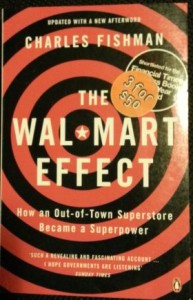
Wal-Mart is the biggest company on Earth, ever. Around 7.2 billion people shop there in a year – more than one visit for every person on the planet. It’s expanding across the globe from Britain to Brazil. And it has the power to change our world…Charles Fishman takes us into the heart of the most successful superstore in history to show how the ‘Wal-Mart effect’ shapes lives everywhere, whether overnight cleaners in America, bicycle-makers in China or salmon farmers in Chile. Now Wal-Mart’s influence is so great it can determine everything from the design of deodorant to the shape of a town, working practices to market forces themselves. Fishman asks: how did a shop manage to do all this? And what will the ultimate cost of low prices be?
I’ve heard so much about Wal-Mart and seen so many videos of strangely dressed people shopping there, one thing we didn’t manage to do while in America was to actually walk inside one of their stores and get the Wal-Mart experience. It’s one thing to hear about it, one thing to shop there and another totally different thing to read and understand about the culture and the effect that has everywhere else.
This is a very detailed book about Wal-Mart, it has very little information from within the company as they give out very few details about anything and refused to have anything to do with it until it had been published, this copy has been republished with extra chapters. One study had to be started from scratch because Wal-Mart refused to even give out the locations and numbers of their stores.
So, what is this effect? Wal-Mart insist on giving low prices, every day. But there’s a cost to this, let’s look at deodorant just as a good example. Wal-Mart requested the company to send them deodorant without a box, just imagine 24 deodorants in a box but each of them encased in another box. It’s this other box Wal-Mart requested the company discontinue. And that’s good, isn’t it? Well, yes, in this case it means the company no longer have to order in the small cardboard boxes and the deodorants get put straight into their bigger box of 24 (or whatever number, I just pulled that figure out of the hat I’m not wearing) cutting the cost of packaging and packing, labour and any other costs I’ve missed. It’s not so good for the cardboard company but it’s better for the trees.
Here’s another example. Lawn sprinklers. Nelson supply lawn sprinklers to Wal-Mart who one year decide they don’t want to pay the price they’re quoted and tell Nelson how much they’re prepared to pay. At that point Nelson have the opportunity to tell Wal-Mart where to go but that’s a challenge as Wal-Mart is their largest customer and it’s awkward when you need to do that. So, they lower their price. The following year Wal-Mart request a 5% discount, this continues and at some stage the company has to decide whether to start shipping out of China or cancel Wal-Mart as a customer. They start shipping some parts out of China and each year that this continues more and more parts and some of the assembly comes out of China. The parts get cheaper and worse quality as the years go on, Nelson have to lay off staff. This is not an isolated event, it happens throughout their stock list.
You don’t want me to tell you what happens with salmon as that is even worse, the workers in Chile who developed the salmon farming have dreadful conditions and there are so many salmon in such a small area the area underneath the salmon has stopped growing anything at all.
The workers in Wal-Mart are underpaid despite the company telling everyone they’re paid above standard wages. They are often told to clock off and then sent back to work. Some of the employment problems are easily checked by a quick google, I’d heard of them long before I read the book. Bear in mind this book was published in 2006 and if you do the google thing you’ll find things like this one which has a nice round up showing lack of staff training causing injury, sexual harassment and much more.
They tend to take over any area they’re in. Their low prices make it challenging for other shops to maintain enough sales to stay open, not just shops that sell goods sold by Wal-Mart but sometimes totally unrelated shops. I’m guessing it’s because people start buying at Wal-Mart rather than the other related shops who go out of business and then the population can’t afford to buy at these unrelated shops. Unemployment tends to go up when a Wal-Mart opens in a new area and full-time employment at Wal-Mart is really only part-time as they’ve reclassified full-time as few hours than other places.
Prices can’t reduce every year as there’s a little thing called ‘inflation’ where prices increase each year. Prices of goods increase, wages increase, cost of electricity, gas, water, sewerage, transport, gas/oil and so much more. When your largest customer keeps telling you to reduce your prices each year then something has to give and that is often the quality and the workforce.
I’m trying to remember the information in this book is several years old and therefore things might have changed but from what I’ve read over the past three or four years about Wal-Mart I don’t think that’s at all likely. What needs to happen is the same for any large corporation and that is change has to happen from the top down, headquarters need to have a good look at themselves, how they are perceived and what damage they’re causing so they can then start to initiate change culture.
One thing I’m saying is that if Wal-Mart tries to come here I’ll be recommending they don’t. And if you’re selling a product in a country that does have a Wal-Mart don’t get sucked into the Wal-Mart Effect as there’s a chance you’ll go out of business with their ‘always low prices’ and their habit of requesting a 5% reduction each year.
I know I’m meant to be talking about the book but I got rather distracted by the topic of the book. There is so much more I could say but it would just be variations on a theme. If you don’t believe me just read the book and have your own thoughts. I can’t see how prices can go down each year and still have the companies at the other end actually making money.

